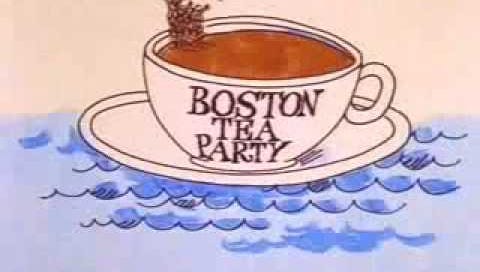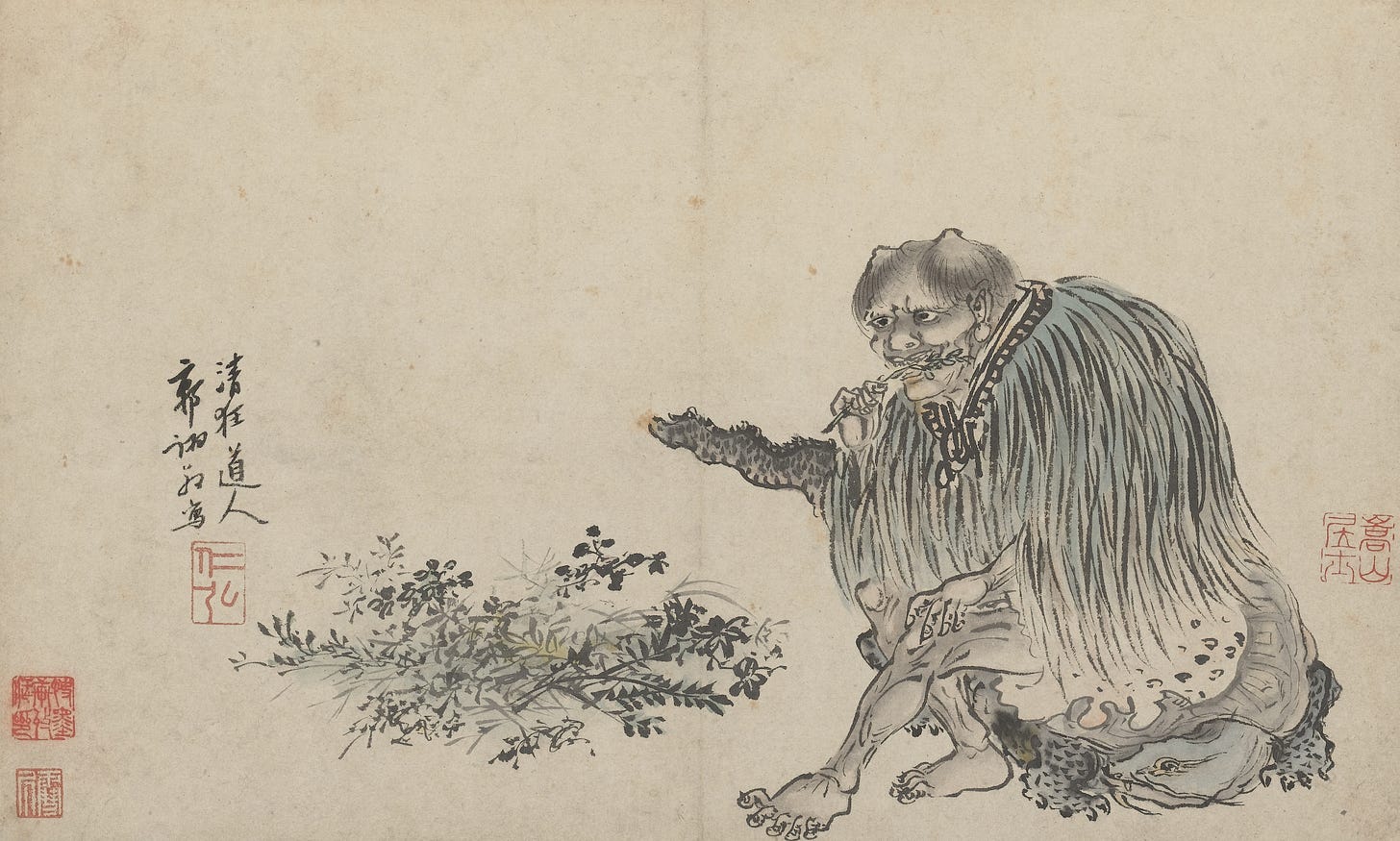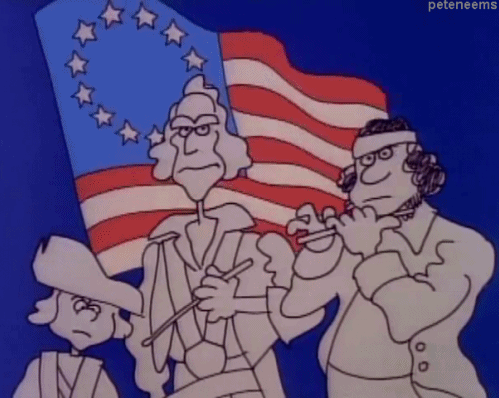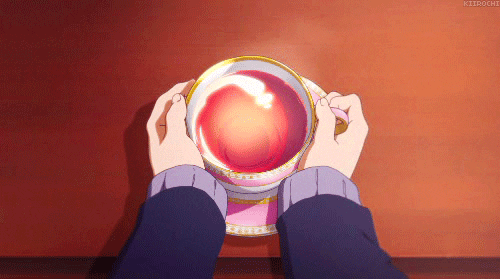3 March 2023, San Diego, California, USA
No matter which way you steep it, tea was born in China.
Chapter I: 9,000 mi
China has been steeping and enjoying tea since the 2000’s BCE, and as lore has passed down Emperor Shen Nung (also seen as Shennong), a well known herbalist and farmer - talk about an interesting man - was relaxing beneath a tree while a servant boiled water for him to drink. As the water boiled and became warmer and warmer still, a gust of wind plucked leaves from his sheltering tree and thrust them into the boiling vessel of water. The tree was Camellia Sinensis. The year of 2737 BCE.

As legend continues, Emperor Shen Nung, the free thinking, hippie-herbalist that he was, takes a little sippy sip of the boiling water libation, with the leaves floating about. He likes it. Bada bing, bada boom, tea as the official drink of China is born.
Whether this legendary historical cartoon is the stuff of tales passed down and shape shifted into school house rock rememberability, or if it actually happened, the fact is tea has run through the veins of China for thousands of years. Because of Emperor Shen Nung, we have tea as we know it in the West.1
After its discovery, tea became an integral part of Chinese everyday life, spiritual ritual and medicine. If one analyzes the work of Confucius across 551 - 479 BCE you must note the golden Mean, or the nucleus of Confucianism: the ideal that equilibrium of reason, ie. you cannot be polarizing in your thinking/gotta consider all sides of the story, must reign for human actions to elicit a valued life2 - we also read of a similar Mean in Aristotle's3 teachings.
This ideal of equilibrium of harmony is at the heart of the Chinese tea ceremony, deux examples:
The balance of human action and time. One needs to stop and focus in order to begin, enjoy and close a tea ceremony
Elements of juxtaposing houses, specifically fire and water, work together to create equilibrium, the heated water brings us an active base in which we can bathe our tea leaves and coax them into releasing their precious soluble compounds that are then dissolved into the water and tossed down our thirsty human gullets
After Confucius, tea became an acceptable gift for the Emperor, it gained its own character in the alphabet4 and was a critical part of Chinese society with a knowledge of tea representing rank, elegance and sophistication. Historians have even unearthed containers for storing tea in tombs of high ranking figures in society during the Han, 206 BCE - 220 AD, and Tang, 618 - 906 AD, dynasties5.
Later in the 8th century, author Lu Yu published Ch’a Ching, or the first book devoted entirely to tea. After Lu Yu’s novel topped the charts, Japanese monks traveling around China with the mission of study, experienced tea and its culture - they brought this back with them to Japan. Over the following centuries tea drinking and ceremony became a critical part of the Japanese daily culture and much of their enduring tea tradition can be traced back to Lu Yu’s, Ch’a Ching.
Chapter II: The Europeans
In documents and text from late 1500’s across Europe we begin to spy little bits mentioning tea. Fascinatingly, although not so surprising if you are familiar with their intrepid and sometimes dicey exploration history6, Portuguese people were the tea trendsetters within Europe, the first tea influencers, if you will. In the 1500s Portuguese people were missionaries, spreading the Good Word, and merchants, making that money, in other words they were all over the place and crushing quotas as the OG AEs7 of their time. Between these two classes, Portuguese people made their way through Asia to China, where they of course had a spot of tea with the locals and began spreading the news about tea.
During the 16th century, with trade between Europe and Asia strengthening and nautical technology evolving it was not the Portuguese, the chief Euro word spreaders of tea, who began engaging in the acquisition and trade of tea, rather it was the Dutch.
By the 1600’s the Dutch established a trading post on the island of Java, today within Indonesia, and with Java as the broker in 1606 the Dutch shipped their first PO of tea from China, through Java to Holland. Quickly, tea became quite the thing and, given its lofty imported price, was popular among the wealthy and upper classes. As the Dutch carved out their market share of the tea trade, the British East India Company8 was 6 years into building a soon to be monopoly on the import of goods from outside of Europe. At this time, tea had not yet spread to the Northern Isles of Europe.
Despite the Dutch commercializing tea, the drink came, socially, to the masses in the English speaking world through a Portuguese Princess, Catherine of Braganza.
Chapter III: We’re not European, We’re British
Note: You are now entering the chapter of WIOW: Tea featuring a faithless, and unrequited love matched, royal marriage.9
In this corner: King Charles II. Ladies-man-extraordinaire. Long, curled and voluminous coffee colored hair and a snappy mustache to match. In exile for 9 years on the European continent after his daddy’s head was lobbed off by Oliver Cromwell. Restored to the English throne in 1660 to kick off the Constitutional Monarchy we recognize in England today. He sired 16 bastard children but none with his wife and Queen.

In the next corner: Catherine of Braganza. Petite, Portuguese and super gosh dang loaded. She has long black, beautiful hair and apparently expressive eyes pleasing to Charlie. Queen Catie, 21, is the third child of King John IV of Portugal and so amped that she gets to marry Charlie. Despite her grand royal lineage and wealth, her stock was down down Dow down on the European Royal Marriage Market (Apparently there were more enticing/profitable royal feminine stocks out there to be had). She may have loved Charlie, but he took her for her material means. Catherine’s £300,00010 dowry included Tangier, Bombay, trade agreements with Portugal and its colonies, cash and her personal adoration of tea.

When Catherine married Charles II in 1662, tea was floating around and being traded across England, however it was Catherine, new and young Queen of England, fresh from Portugal with her wealth ushering in an improved Carolingian era, who made tea popular.
As tea became a fashionable drink across court and the English upper classes, the East India Company pounced and placed its first order for 100 lbs of Chinese tea to be imported through Java in 1664.
Given Catherine restored British coffers post Civil War and encouraged tea drinking in the one place in the world everyone drinks and thinks of tea - while not producing an heir for the throne, she was def not a bad social acquisition for the British monarchy.
While tea drinking and culture became more and more embedded in everyday life in England, the British East India Company became the chief importer of tea from China to its colonies, Europe, and beyond. In 1834 the East India Company ceased its tea trade with China and began to cultivate its own tea crops in India, by 1839 assam tea was born and began to be auctioned in Britain.
Chapter IV: Taxation & those Pesky Colonists
Welcome to the singular mention of the Boston Tea Party you will read on 21st & 18th - please note, I find Colonial times sexy, interesting, even good fashion fodder but I do not know what it is, I cannot ingest any more on the big ole Beantown Tea Party. For the sake of Two Weeks of Tea, it is necessary to transport you, Reader, to the wee hours of a chilled December day in 1773. We are at Griffin’s Wharf, in Boston and us and a few Colonial patriot pals are dressed as Native Americans - really throw those British tea-bags off the scent - and we are about to toss 342 chests of Chinese tea, owned by the East India Company, into the harbor. In the name of unjust taxation - obviously, this topic is still a favored by Americans.
In this case, the taxation was indeed unjust (classic American I have joined the cause). In the late 1700’s the East India Company was responding to the frustrating issue of tea smuggling, since the product was becoming more and more popular and they were controlling all legal trade of tea to Europe and England’s colonies, smuggling was becoming a major problem. The East India Company attempted to make up for these losses through tariffs. The British government supported these additional tea taxes on their colonies, especially America, as the East India Company was £1 million in debt to the Man and the Man wanted its shillings back.
After trying and trying for a solution to stop the bleeding by tea smugglers, the East India Company resorted to taxes and for the Americans that meant, 3 pennies owed on every pound of tea shipped to America - this was only one in a party of taxed commodities levied in the Townshend Acts11 that drove American Colonists even further toward their thirst for independence from England.
After the Townshend Acts and the Colonists dumping loads of tea into the Boston Harbor and they eventually gain their independence from England. Rock on America. Post America’s independence the tea trade continues and grows, beyond Europe and North America, tea was beginning to be found and enjoyed around the world.
With its roots in India and being controlled by England, the East India Company’s power wavered as colonies fled from the British and after the Indian Rebellion of 185712 and under the Government of India Act of 185813 the company was nationalized until it was later officially dissolved in 1874.
While the East India Company was imploding, tea trade became a free for all. And our merchant friends from around the world took advantage.
1834 saw the new invention, the Clipper, a ship, sleek, narrow, full of sails and known for their speed. The Clipper allowed for American, British, and European merchants to sail ‘round the world more efficiently and transport more product. Tea continued to boom.
Chapter V: For the Love of Tea
If at this point in WIOW: Tea, you are thinking: Wow, how has Netflix, HBO, Starz, BBC, or even Masterpiece not taken an in-depth and potentially sensual historical look at tea history and made it into a titillating series? You are not alone. Tea, much like the harvesting and trade of diamonds, spices, or human and animal cargo is a commodity that has been the backdrop of seismic moments in Western and Eastern history.
This is simple to state and prove because tea, like wheat or wine, has become an integral part, not of one specific culture, but all of humanity. Today Camellia Sinensis has been so manipulated and cajoled that we now have over 2,000 types of tea growing around us, the best bit is no matter the tea type, black, oolong, green or white, all teas as we know them stem from the original leaf steeped and enjoyed by Chinese Emperor Shen Nung in 2700 BCE.
It is well known that tea is an enjoyable habit, it tastes lovely, is warm and comforting and comes in a variety of flavors just waiting to be improved upon with milks, creams, brown or white sugars, even honeycomb, yet after all these years do we understand how much more tea offers beyond taste?
Tea is said to be the second most popular drink in the world, after water. It is rife with antioxidants, amino acids, proteins, minerals, and vitamins that feed and stoke the body and brain. From a caffeine perspective, tea’s caffeine content is such that it gently prods the central nervous system, optimizing mental acuity and physical reaction times while at the same time, an amino acid found in tea, L-theanine, is proven to exert a calming effect on the body and mind. Incredible, really.
There is this great scene in Family Guy, in one of its 21 seasons, where Peter is pretending to be his wife Lois and mimicking her daily tasks. Peter sits down at the kitchen table and holds a warm, steaming cup of tea in two of his hands and lets out a big big sigh. While Peter may have been being his pumpkin eater self, there is no better sigh than one had with two hands cupping a ceramic mug bubbling with strong, hot tea. It is reassuring, it is a moment for you, it is being present, it has zero calories, and that sigh, that release, it is so excellent for you.
Once while I was living in China, I went for tea with a friend. We ordered in Chinese and ended up with pink tea. I’ll never forget how incredible that incident was. It was centuries of traditions wound up in my Peter Griffin moment enjoyed by an American 20-something who was raised on tea parties, Elizabeth Gaskell14 and Jane Austen15 - it was as complex, simple and wonderful as tea.
We shall see you in a few days with Vintage Finds, Two Weeks of Tea edition.
Until then, we would love to hear your tea stories. Feel welcome to share with us below.
Cheers,
LLW
God bless you for giving us tea, China
Confucian ethics place value on fairness, justice, honor, care and courage, good things if you ask me…very, Dead Poets Society
Ancient Greek philosopher & polymath, ie. genius, who lived 384 - 322 BCE
茶, Chá
King Tut went to his eternal rest with thousands of pound of solid gold, the Chinese simply required their tea *This is an obvious overstatement to help you understand how important tea was and is to Chinese culture*
The likes of Christopher Columbus, Ferdinand Magellan, Vasco de Gama - Not super popular these days
SF slang for Account Executive, otherwise known as the unique young adult who can survive off of caffeine, free office snacks and Whole Foods smoothies and make up to 75 cold calls per day
The bad guys in Pirates of the Caribbean
Shocker
To understand how vastly wealthy Catherine of Braganza was, please use this Historical Currency Calculator from the National Archives UK (Year: 1660, Sum: £300,000)
In 1767 the British government imposed taxes on their American subjects which applied to glass, lead, paint, paper, and, the big kahuna, tea
A major uprising of Indian people against the British East India Company that was, up until that time, operating as the sovereign ruling party on behalf of the British Crown
Act by the UK Parliament to liquidate the assets and dismantle the power of the British East India Company as a ruling entity in India
English writer from the Victorian era, she lived from 1810 - 1865 and her novels may take a while to preheat, but after they reach their boiling point they will knock your stockings off
Chief female British novelist who lived from 1775 - 1817, she is iconic and so too are her heroines















Reading reference list:
https://akjournals.com/view/journals/204/42/1/article-p59.xml
Royal Museums of Greenwhich: https://www.rmg.co.uk/stories/topics/chinese-tea-ceremonies-traditions
US National Library of Medicine: https://www.nlm.nih.gov/exhibition/chinesemedicine/emperors.html
UK Tea and Infusions Society: https://www.tea.co.uk/history-of-tea
Art UK: https://artuk.org/discover/stories/catherine-of-braganza-the-lost-stuart-queen
Art UK: https://artuk.org/discover/stories/storm-in-a-teacup-a-visual-history-of-tea
National Portrait Gallery: https://www.npg.org.uk/collections/search/person/mp00804/catherine-of-braganza
National Archives Currency Calculator: https://www.nationalarchives.gov.uk/currency-converter/#currency-result
Royal Family UK: https://www.royal.uk/charles-ii#:~:text=Charles%20II%20spent%20the%20next,restored%20to%20his%20father's%20throne
How to Make Tea: The Science Behind the Leaf, Brian R. Keaton & Kim Long
The Analects of Confucius